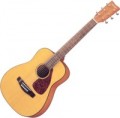Size
The overall size of the body of the guitar.
This parameter is used to select the instrument according to the personal characteristics of the musician. Even adult guitarists can vary greatly in body type, not to mention children of different ages learning to play the guitar. Accordingly, guitars for different people should have different sizes.
It is customary to indicate the size as a fraction: for example, the largest guitars are indicated as
4/4(full size). A smaller number, accordingly, denotes a smaller case, although the proportion is not strict. For example, the total length of a classical guitar (see "Type") in 4/4 is usually 1 m, and in
3/4 is 885 mm.
The smallest instruments on the market today are 1/8. They, as well as the slightly larger 1/4, are intended for children up to 6 years of age. For the age category of 6 – 9 years, the best tool is
1/2, at 9 – 11 years old — size
3/4, for teenagers and people of petite build, models 7/8 are produced, and full
4/4 are designed for boys and adults of average and large build. At the same time, all these recommendations are rather conditional, and in fact it is worth considering not only age, but also the specific specifics of each person: for example, a 4/4 guitar that has grown up quickly at the age of 13 may be quite suitable
.... It is also worth remembering that the shape of the body also significantly affects the dimensions of the guitar (see “Shape (view”)).Anchor
The type of truss provided in the guitar neck design.
The truss rod is a long metal rod located inside the neck of the guitar (along it). It is designed to provide the desired stiffness and prevent neck distortion due to string tension. This function is relevant for models that use metal strings — primarily acoustic ones (see "Type"); Nylon guitars don't need an anchor.
Often it is possible to adjust the tension force of the anchor — to change the degree of deflection of the neck. This can be useful both for adjusting to the guitarist's preferences and for correcting neck distortion that develops over time.
Note that the lack of information on the anchor does not mean the absence of the latter: some manufacturers simply do not bother to mention it in the basic data on the tool. So in such cases, you can try to find more detailed information on the selected model.
Specific options for the anchor can be as follows:
— Single. An anchor in the form of a single rod is the simplest and most inexpensive option. At the same time, the strength and rigidity of such a rod is sufficient in most cases.
— Double. Twin anchor, consisting of two rods. A pair of rods provides increased strength and reliability compared to a single truss rod, and also provides additional protection against lateral deformations of the fingerboard (deviations to the right / left). At the same time, a double anchor is not cheap, despite the fact...that the described advantages are really important only in professional music, where even the slightest deviations from the reference sound are unacceptable. Therefore, the double anchor is found mainly in premium tools.
— Is absent. The complete absence of an anchor in the design of the neck. Despite the useful properties of this part, its use is far from always justified: for example, the neck can be made of durable and elastic materials that “work” well without additional reinforcement. Another reason for the one-piece construction is that mounting a metal rod disrupts the neck's uniformity and can degrade the instrument's acoustic performance, which can be critical on high-end models. Note that the absence of an anchor is separately indicated only for acoustic guitars and other instruments with metal strings; in "nylon" models, rods are not used by definition, and there is no need to specifically specify its absence.
Scale
Scale length of the guitar. The scale in this case is the working part of the string, in other words, the distance from the saddle (on the headstock) to the saddle (on the bridge). In most acoustic and similar guitars, the scale is set during production and is unchanged. Without going into technical details, we can say that the value of this parameter is generally a reference: it allows you to some extent estimate the overall dimensions of the instrument, as well as the size of the frets (the longer the scale, the larger the size of the frets, regardless of their number). However, there is also a practical application: with an adjustable anchor (see above), the scale length data can be useful in the tuning process.
Case
The presence of a
case or cover in the tool delivery kit (what exactly is included in the kit must be specified in each case separately).
A case is called a case made of hard materials, a case is made of soft materials, this is the main difference between these types of accessories. Otherwise, they are similar: both the case and the cover are provided primarily for the convenience of transporting the tool. To do this, the design provides for handles, shoulder straps and other devices that facilitate carrying, as well as compartments for additional accessories (replaceable strings, tuners, etc.). However, it is desirable to store the tool in a case or case — to protect it from dust and other adverse factors.
The “native” case/case is good because it optimally fits a specific guitar model and is immediately sold with it, saving the owner from unnecessary searches. On the other hand, manufacturers often include the simplest types of cases in the kit, with minimal additional features and a very limited degree of protection. This is especially true for cases that can be made of thin material and are only suitable for short-distance movements in warm weather without rain. Therefore, sometimes it makes more sense to buy a case separately.

